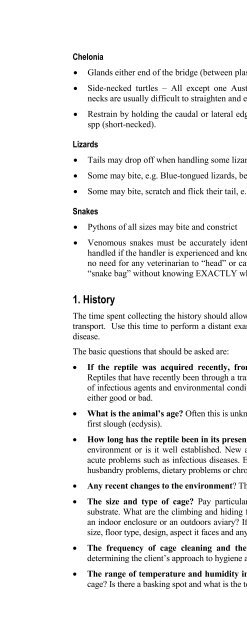Handling and Nursing Reptiles - Australian Veterinary Association
Handling and Nursing Reptiles - Australian Veterinary Association
Handling and Nursing Reptiles - Australian Veterinary Association
You also want an ePaper? Increase the reach of your titles
YUMPU automatically turns print PDFs into web optimized ePapers that Google loves.
Chelonia<br />
<br />
<br />
<br />
Lizards<br />
<br />
<br />
<br />
Snakes<br />
<br />
<br />
Gl<strong>and</strong>s either end of the bridge (between plastron <strong>and</strong> carapace) discharge a pungent fluid.<br />
Side-necked turtles – All except one <strong>Australian</strong> freshwater species are side-necked. The<br />
necks are usually difficult to straighten <strong>and</strong> examine.<br />
Restrain by holding the caudal or lateral edge of the carapace. Avoid the mouth in Emydura<br />
spp (short-necked).<br />
Tails may drop off when h<strong>and</strong>ling some lizards (small skinks <strong>and</strong> geckoes).<br />
Some may bite, e.g. Blue-tongued lizards, bearded dragons <strong>and</strong> eastern water dragons.<br />
Some may bite, scratch <strong>and</strong> flick their tail, e.g. varanids (monitors).<br />
Pythons of all sizes may bite <strong>and</strong> constrict<br />
Venomous snakes must be accurately identified before the physical examination <strong>and</strong> only<br />
h<strong>and</strong>led if the h<strong>and</strong>ler is experienced <strong>and</strong> known by the veterinarian to be competent. There is<br />
no need for any veterinarian to “head” or catch a venomous snake. Never put your h<strong>and</strong> in a<br />
“snake bag” without knowing EXACTLY what is in it!<br />
1. History<br />
The time spent collecting the history should allow the reptile to settle down from the excitement of<br />
transport. Use this time to perform a distant examination of the patient to look for subtle signs of<br />
disease.<br />
The basic questions that should be asked are:<br />
<br />
<br />
<br />
<br />
<br />
<br />
<br />
If the reptile was acquired recently, from what source? Wild caught or captive bred?<br />
<strong>Reptiles</strong> that have recently been through a transfer may have been stressed or exposed to a host<br />
of infectious agents <strong>and</strong> environmental conditions. Some sources are know by reputation to be<br />
either good or bad.<br />
What is the animal’s age? Often this is unknown. If it was hatched recently ha it undergone its<br />
first slough (ecdysis).<br />
How long has the reptile been in its present environment? Is the animal settling in to a new<br />
environment or is it well established. New arrivals are more likely to suffer from stress <strong>and</strong><br />
acute problems such as infectious diseases. Established animals are more likely to suffer from<br />
husb<strong>and</strong>ry problems, dietary problems or chronic diseases such as neoplasia or parasites.<br />
Any recent changes to the environment? This may indicate sources of stress or toxins.<br />
The size <strong>and</strong> type of cage? Pay particular attention to the nature of the floor surface or<br />
substrate. What are the climbing <strong>and</strong> hiding facilities provided? Is the reptile normally kept in<br />
an indoor enclosure or an outdoors aviary? If it is in an aviary ask for a description noting the<br />
size, floor type, design, aspect it faces <strong>and</strong> any preventative medicine program currently in use?<br />
The frequency of cage cleaning <strong>and</strong> the cleaning methods used? This is a means of<br />
determining the client’s approach to hygiene <strong>and</strong> some potential sources of toxins.<br />
The range of temperature <strong>and</strong> humidity in the cage? Is there a temperature gradient in the<br />
cage? Is there a basking spot <strong>and</strong> what is the temperature where the reptile is able to bask?

















